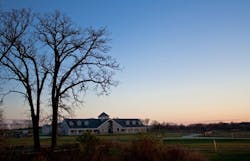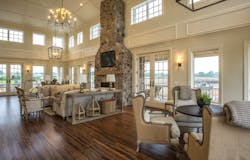A Traditional Idea Made New: Agrihoods
In Kane County, Ill., a developer courting one of three neighboring family farms to sell land told one farmstead’s owner, “The next time you go by this place, you won’t even recognize it.” The developer thought he was impressing the farmer with his vision to transform fields into a thriving suburban community. But the farmer, whose family had tilled these acres since the early 1900s, inferred that the developer was going to wipe out his heritage. Jane Strickland had better luck.
Agrihoods as a Form of Farmland Preservation
The Fort Wayne, Ind., resident had been searching for a location to start a horse stables business and had bought one of those family farms in 2001. She soon saw that suburban sprawl from Huntley, Elgin, and other suburban Chicago enclaves was pushing westward. Almost always when residential development creeps next to farmland, the two coexist for a time but eventually the farm is annexed and disappears. Strickland and her brother, John DeWald, a San Diego developer as well as a trained biologist and chemist, sought a way to preserve the county’s farmland. They proposed an idea that became Serosun Farms and won over the neighboring Allens and Grollemonds who saw the development as one that would preserve the legacies of their farming families. Even some of the roads and a pond are named after the families and their children.
There are now at least a dozen agrihoods—planned communities with housing built around working farms—such as Serenbe near Atlanta, Agritopia in Phoenix, and South Village in Burlington, Vt. Homeowners tired of the city’s hustle and bustle are drawn to pastoral country living and being near organic farms that supply locally grown food for farm-to-table markets and farm-to-fork restaurants. Much like the golf course, pool, or tennis courts were unifying amenities in master planned communities, food is emerging as a community-building tool.
“Whether it’s community farms, on-site restaurants, or even individual plots where residents can get farming lessons to grow their own vegetables, I think it’s here to stay,” says Todd LaRue, managing director of real estate consultancy RCLCO in Austin, Texas. “I don’t think it’s a fad, even though it’s tough to figure out how to make the economics work with running a community farm.”
Making Space for Agriculture
Critics deride some agrihoods as overgrown gardens because, in some cases, just 16 acres may be actual farmland. However, 75 percent of Serosun’s 410-acre parcel is reserved for agriculture, green space, and natural areas. Strickland and DeWald convinced Kane County to approve a new zoning category called “agriculture preservation limited development” for a planned unit development that holds farmland preservation as its primary mission and residential development as secondary. The designation enables Strickland and DeWald, as well as homebuyers who are borrowing money to buy land, to take on agriculture loans, which charge lower interest rates and have friendlier lending terms than land development loans.
The zoning was approved in 2009—not the best time for new construction. The sibling developers spent part of the housing slump restoring wetlands, prairie, fishing ponds, and a 40-acre oak tree savannah with 8 miles of trails. The farm already is a profit center: organic hay grows on 165 acres to feed horses at Strickland’s equestrian center and to sell to nearby stables. The Strickland family also successfully raises poultry and eggs. Eventually an apple orchard will be planted behind the development’s entrance, and more land will be farmed and assigned to community and demonstration gardens. Future phases include opening an on-site farmer’s market, a restaurant serving food sourced from Serosun and nearby farms, and an artisan center along with a pool, game room, and event facilities.
Seeking Community
Last June, the developers opened a 3,800-square-foot model home, a high-performance American Foursquare design on one of the 114 one-acre lots set aside for custom-built homes. Among Serosun buyers and prospects, so far, are professionals who want to raise their children on a farm without the burden of managing or working it—contract farmers handle those duties. Others are couples who want a second country house just 50 miles from downtown Chicago and retirees who grew up on a farm and want to return to their country roots.
“People want a community,” DeWald says. “One of the things that’s drawing these smaller planned developments is that more people want to live in interesting communities, not just a suburban subdivision. You see more mixed-use projects in a downtown. Why people want to live downtown instead of in a house in a stale setting has more to do with the community, that lifestyle, the interaction. Introducing a farm is another way to add life to a project and create a community.”




